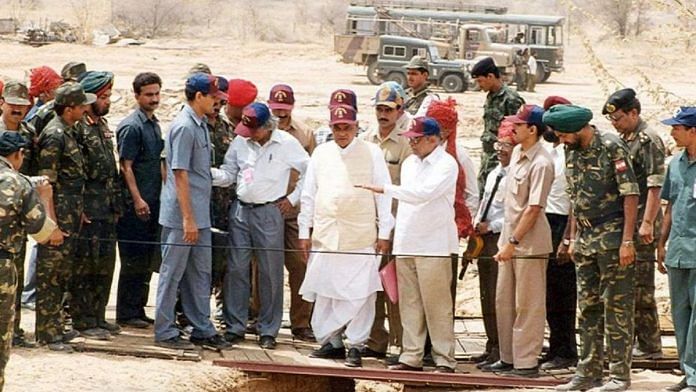The sun was still rising over Washington DC when a cryptic message was sent to New Delhi — ‘the White House has collapsed’. This mysterious and cheeky code message was sent by the 58 Engineer Regiment of the Indian Army and with this five-word message India declared itself a nuclear weapons state.
India detonated three nuclear weapons simultaneously on a hot, dusty afternoon on 11 May 1998 in the Thar Desert at Pokhran.
In a hurriedly-called press conference, Prime Minister Atal Bihari Vajpayee declared India a nuclear weapons state. An official statement said “Measurements have also confirmed that there was no release of radioactivity into the atmosphere [at Pokhran]. These were contained explosions like the experiment conducted in May 1974.”
The mighty roar was heard as far as the actual White House. Then US President Bill Clinton exclaimed, “We’re going to come down on those guys [India] like a ton of bricks”, wrote TP Sreenivasan in his book Words, Words, Words: Adventures in Diplomacy.
India had taken the mighty Central Intelligence Agency (CIA) and the world by surprise, they had not detected the preparations for the test.
Also Read: Why Buddha would be frowning at Ukraine today, and why India got it right with Pokhran 1 and 2
Three detonations
25 years have passed since the Pokhran atomic explosions that rewrote the history of India, asserting it as a global power. The anniversary is celebrated as National Technology Day and Prime Minister Narendra Modi will lead the charge with a national event at the Pragati Maidan in New Delhi this year.
Modi, in a way, is reaping the benefits of the immense fallout of that atomic blast as India embarks on becoming a developed nation by ensuring a higher standard of living, better health care and a cleaner environment. A ‘New India’ is fast emerging with New Delhi getting ready to host 20 of the world’s most powerful leaders at the G-20 Summit later this year.
In a 2009 press conference, the government revealed that India conducted five nuclear tests of advanced weapon designs on 11 and 13 May 1998. The first three detonations took place simultaneously at 3:45 pm on 11 May. These included a 45 kiloton (kt) thermonuclear device, a 15 kt fission device and a 0.2 kt device. The two nuclear devices detonated simultaneously on 13 May were in the range of 0.5 and 0.3 kt.
The Indian army had assigned code names to each of the shafts where deep underground the tests were conducted. The deepest shaft housed a large hydrogen bomb that could annihilate full cities. The shaft was code-named ‘White House’. Hence the cheeky code message indicating the mission’s success.
In a conversation with me on Khul Ke, a social media platform on Wednesday Anil Kakodkar, then director of the Bhabha Atomic Research Center (BARC), Mumbai and one of the four key architects of the Shakti tests said that the fission bomb was a refined version of the 1974 device and the ‘chottus’ (smaller ones) were all tactical weapons. In his book, Weapons of Peace: The Secret Story of India’s Quest to be a Nuclear Power, Raj Chengappa writes that experts suggest the key nuclear fuel India used was the human-made radioactive element plutonium, which was produced and refined from Indian reactors.
It took 24 years after India’s first nuclear test, nicknamed ‘Smiling Buddha’, to conduct the second set of tests. Kakodkar was just 30 years old at the time of the first test. He’s one of the few scientists who has worked end to end on India’s nuclear energy programme.
“India was a reluctant entry into the nuclear weapons club,” Kakodkar said, adding that one should not lose the coincidental significance of both the explosions having been conducted on Buddha Purnima or Buddha Jayanti. He also stated that India has never been an aggressor nation.
Also Read: Indian scientists planned nuclear test in 1997. But PM Deve Gowda gave 3 reasons to say no
No first-use policy
Soon after the 1998 atomic explosions Prime Minister Vajpayee declared a ‘voluntary moratorium’ on nuclear weapons testing which still holds. He also enunciated the ‘credible minimum nuclear deterrence policy’ and ‘no first use of atomic weapons’ as the abiding principles. India’s nuclear-armed neighbour Pakistan has no such humanised nuclear doctrine.
Nuclear weapons still remain the currency of power in the global world order. It has come to the fore again as the war continues in Ukraine. Closer home, the responsibilities of being a nuclear weapons State were not missed when one of Prime Minister Narendra Modi’s first official visits in 2014 was to BARC to interact with India’s nuclear scientists.
Despite having blasted itself into the small clique of nations having advanced nuclear weapons, India continues to be a supporter of global nuclear disarmament.
No doubt after the ‘White House collapsed’, the India-US friendship has only grown by leaps and bounds. Very soon the two nations will be jointly launching the world’s costliest Earth-imaging satellite — the NISAR satellite, which costs over $1.5 billion. No wonder Kakodkar described India’s atomic bombs as “weapons of peace”.
Pallava Bagla is a science journalist who has closely reported on the atomic and space programmes. Views are personal.
(Edited by Theres Sudeep)



